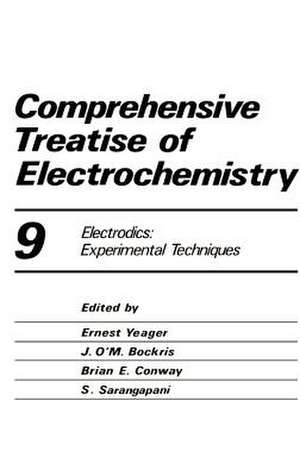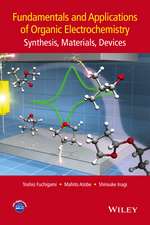Comprehensive Treatise of Electrochemistry
Editat de Peter Horsman, Brian E. Conway, E. Yeageren Limba Engleză Hardback – 31 oct 1984
| Toate formatele și edițiile | Preț | Express |
|---|---|---|
| Paperback (6) | 405.06 lei 6-8 săpt. | |
| Springer Us – 15 apr 2013 | 405.06 lei 6-8 săpt. | |
| Springer Us – 12 oct 2011 | 411.42 lei 6-8 săpt. | |
| Springer Us – 7 dec 2013 | 659.20 lei 6-8 săpt. | |
| Springer Us – 25 feb 2013 | 660.18 lei 6-8 săpt. | |
| Springer Us – 21 ian 2012 | 664.93 lei 6-8 săpt. | |
| Springer Us – 21 dec 2011 | 671.14 lei 6-8 săpt. | |
| Hardback (1) | 1230.66 lei 6-8 săpt. | |
| Springer Us – 31 oct 1984 | 1230.66 lei 6-8 săpt. |
Preț: 1230.66 lei
Preț vechi: 1500.81 lei
-18% Nou
Puncte Express: 1846
Preț estimativ în valută:
235.52€ • 243.30$ • 196.01£
235.52€ • 243.30$ • 196.01£
Carte tipărită la comandă
Livrare economică 26 martie-09 aprilie
Preluare comenzi: 021 569.72.76
Specificații
ISBN-13: 9780306415708
ISBN-10: 0306415704
Pagini: 451
Ilustrații: XVII, 451 p.
Dimensiuni: 178 x 254 x 32 mm
Greutate: 0.82 kg
Ediția:1984
Editura: Springer Us
Colecția Springer
Locul publicării:New York, NY, United States
ISBN-10: 0306415704
Pagini: 451
Ilustrații: XVII, 451 p.
Dimensiuni: 178 x 254 x 32 mm
Greutate: 0.82 kg
Ediția:1984
Editura: Springer Us
Colecția Springer
Locul publicării:New York, NY, United States
Public țintă
ResearchCuprins
1. Quantum Electrochemical Kinetics: Continuum Theory.- 1. Introduction.- 2. The Model.- 3. General Expressions for the Transition Probability.- 4. Transition Probability for Fixed Coordinates of the Ions and Reactants.- 5. Proton Transfer Reactions.- 5.1. Proton Transfer in the Case of Strong Coupling with the Medium.- 5.2. Proton Transfer in the Case of Weak Coupling with the Medium.- 6. Effect of the Discrete Structure of the Electrical Double Layer on the Kinetics.- 7. The Step of Electrochemical Desorption of Hydrogen Atoms.- 8. The Role Played by the Electronic Structure of the Electrode.- 9. Experimental Verification of the Theory.- References.- 2. Molecular Aspects of Quantum Electrode Kinetics.- 1. Introduction.- 2. Correlation between Electrochemical Electron and Spectroscopic Photon Transfer Process.- 3. Applicability of Time-Dependent Perturbation Theory for Electron Transfer Processes at Electrodes.- 4. Proton Transfer at Interfaces.- 4.1. Gurney’s Quantum Mechanical Model of Proton Transfer.- 4.2. Butler’s Modification of Gurney’s Model.- 4.3. The Quantum Character of Proton Transfer.- 4.4. Degree of Validity of the WKB Tunneling Probability Expression for Proton Transfer.- 4.5. A Model of Electrochemical Hydrogen Evolution Reaction.- 5. Quantal Aspects of Photoelectrochemical Kinetics.- 5.1. Photoeffect at Metal-Solution Interface.- 5.2. Non-Tafel Behavior of Photocurrent at Metal-Solution Interface.- 5.3. Photoeffect at Semiconductor-Solution Interface.- 6. Tunneling at the Oxide-Covered Electrode.- 7. Fermi Energy in Solution.- 8. Distribution of Electron States in Ions in Solution.- 9. The Adiabaticity and Nonadiabaticity in Electron Transfer Reactions.- 9.1. Landau-Zener Formulation.- 9.2. Transmission Coefficient, K, for Homogeneous RedoxReactions.- 10. Transition Probability of the Electron at the Electrode-Solution Interface.- 11. Concluding Remarks.- References.- 3. Kinetics of Electrochemical Reactions at Metal-Solution Interfaces.- 1. Introduction: Steps of Electrode Processes.- 2. Phenomenological Theory of the Elementary Act of an Electrode Reaction.- 2.1. Brønsted-Polanyi Relation and Electrode Reaction Activation Energy.- 2.2. Electronic Work Function and Related Values in Electrochemical Kinetics.- 2.3. Activity Coefficient of an Activated Complex.- 2.4. Temperature Dependence of Electrode Reaction Rates.- 2.5. Activationless and Barrierless Electrode Processes.- 3. Formal Kinetics of Electrode Reactions.- 3.1. Kinetic Equations.- 3.2. Stoichiometric Numbers.- 4. Electrode Double-Layer Structure and Electrode Reaction Rate..- 4.1. Basic Relations.- 4.2. Hydrogen Evolution.- 4.3. Reduction of Anions.- 4.4. Electrode Reactions of Organic Compounds.- References.- 4. Electrocatalysis.- 1. Introduction.- 2. Electrocatalysis and Catalysis.- 2.1. General.- 2.2. Effect of Potential on Rate.- 3. The Rates of Complex Processes.- 4. Potential Energy Diagrams and Electrocatalysis.- 4.1. General.- 4.2. Some Correlations.- 5. Some Quantum Mechanical Aspects.- 5.1. General.- 5.2. Radiationless Transfer Theories.- 6. Some Electrocatalytic Reactions.- 6.1. General.- 6.2. Hydrogen Electrode Reaction.- 6.3. Oxygen Electrode Reactions.- 6.4. Organic Oxidations.- 6.5. Chlorine Evolution.- 6.6. General Remarks on Practical Electrocatalysts.- References.- 5. Hydrogen Electrode Reaction on Electrocatalytically Active Metals.- 1. Introduction.- 2. Adsorption of Hydrogen on Metal Electrodes.- 2.1. Hydrogen Wave by a Potential Sweep Technique.- 2.2. Adsorption Isotherm for Atomic Hydrogen.- 2.3. Structure of theHydrogen Wave and Experiments on Single-Crystal Planes.- 3. Basic Kinetic Equations.- 4. Experimental Behavior and Possible Mechanisms—Existence of a Unique Rate-Determining Step.- 4.1. Possible Reaction Routes and Mechanisms.- 4.2. The Stoichiometric Number.- 4.3. The Tafel Slope.- 4.4. Magnitude of the Tafel Slope.- 4.5. The Reaction Orders.- 5. Mechanism with No Unique Rate-Determining Step.- 5.1. Tracer Experiments.- 5.2. Tafel Lines and Reaction Orders.- 5.3. Absence of rds and Affinity Distribution among the Constituent Steps.- 5.4. Synthesis of the Overall Kinetics.- 5.5. Transient Experiments on the Pd Hydrogen Electrode.- 6. Related Topics.- 6.1. Effect of Catalytic Poisons upon the Individual Step Rates.- 6.2. Hydrogen Pressure Equivalent to Hydrogen Overpotential.- 6.3. Electrolytic Hydrogenation of Organic Substances.- 7. Electrode Materials.- 7.1. Pure Metals.- 7.2. Composite Materials.- References.- 6. Oxygen Electrochemistry.- 1. Introduction.- 2. Thermodynamics of the Oxygen Electrode.- 3. Open-Circuit Potentials.- 4. Oxygen Adsorbed Species and Anodic Films on Platinum and Other Noble Metals.- 4.1. Electrochemical Studies.- 4.2. In Situ Optical Studies.- 4.3. In Situ Surface Conductivity Measurements.- 4.4. Ex Situ Characterizations.- 5. The Anodic Oxygen Evolution Reaction (OER).- 5.1. General Features.- 5.2. Kinetics and Mechanisms of the Oxygen Evolution Reaction on Metal and. Oxide Electrodes.- 6. Cathodic Reactions of Oxygen (Oxygen Cathodes).- 6.1. The General Scheme of Parallel and Series Reactions of Oxygen and Hydrogen Peroxide.- 6.2. The Kinetics of Molecular Oxygen Reduction on Different Metallic Electrodes.- 6.3. Oxygen Reduction on Nonmetallic Materials.- 7. Concluding Remarks.- References.- 7. Deposition and Dissolution of Metals andAlloys. Part A: Electrocrystallization.- 1. Introduction.- 2. Kinetics of Atom Incorporation.- 2.1. The Structure of a Crystalline Surface.- 2.2. The Propagation Rate of Steps.- 2.3. The Current Density on a Stepped Crystal Face.- 3. Metal Deposition on a Perfect Crystal Face.- 3.1. Energy and Rate of Formation of Two-Dimensional Nuclei.- 3.2. Kinetics of Step Propagation and Mechanism of Metal Deposition.- 3.3. Deposition Kinetics on Perfect Crystal Faces.- 4. Metal Deposition on Faces Intersected by Screw Dislocations.- 4.1. The Theory of Spiral Growth.- 4.2. Current Density and Morphology of Growth.- 5. Electrolytic Phase Formation.- 5.1. Equilibrium Forms and Forms of Growth of Crystals.- 5.2. The Nucleation Rate.- 5.3. The Nucleation-Rate-Overpotential Relation.- 5.4. Comparison with Experimental Data.- 6. Conclusions and Outlook.- References.- 7. Deposition and Dissolution of Metals and Alloys. Part B: Mechanisms, Kinetics, Texture, and Morphology.- 1. Introduction.- 2. Specific Features of the Thermodynamics of Metal and Alloy Phase Formation and Degradation.- 2.1. Equilibration of a Metal Surface with Electrolyte Containing Metal Ions—the Problem of the Reversible Potential.- 2.2. Reversible Potentials of Alloys.- 2.3. Underpotential Deposition of Metals on Foreign Substrates.- 2.4. Effect of Interactions of the Metal Ion in Solution on the Reversible Potential.- 2.5. Effect of pH on Electrode Potential.- 3. Likely Mechanisms of Metal Ion Discharge and Their Kinetic Consequences.- 3.1. Mechanism and Kinetics of the Electrode Process.- 3.2. Pseudocapacitance Effects and the Concentration of Intermediate Species.- 3.3. Effect of Anions on the Kinetics of Metal Deposition and Dissolution.- 3.4. Effect of Substrate on the Kinetics of Activation-ControlledReactions.- of Metals.- 3.5. Kinetics of Codeposition of Metals and Effects on Alloy Phase Formation.- 4. Totally Irreversible Dissolution of Metals.- 4.1. The “Floating” Electrode Potential.- 4.2. Dissolution with the Formation of Insoluble Substances.- 4.3. Acceleration of Anodic Dissolution of Metals under Strain.- 5. Formation and Physical Properties of Metallic Deposits Obtained under Conditions of Slow Discharge and Incorporation.- 5.1. Effect of Substrate on the Growth of the Deposit.- 5.2. Factors Affecting Grain Size in a Compact Deposit.- 5.3. The Appearance of Texture in Metal Deposits.- 5.4. Development of Stress in Metal Deposits.- 6. Effect of Slow Transport of Species to the Electrode on Surface Morphology of Metal Deposits.- 6.1. Amplification of Surface Roughness.- 6.2. The Appearance and Growth of Dendrites.- 6.3. The Formation of Metal Powders.- 6.4. Effect of Periodically Changing Conditions of Deposition.- 6.5. The Phenomenon of Electropolishing.- 7. Effect of Adsorption of Foreign Substances on Surface Morphology of Metal Deposits.- 7.1. The Growth of Whiskers.- 7.2. Leveling in Metal Deposition.- 8. Conclusion.- References.- 8. Processes at Semiconductor Electrodes.- 1. Introduction.- 2. Potential and Charge Distribution at Solid-Electrolyte Interfaces.- 3. Energy Levels in Solids and Electrolytes.- 3.1. Absolute and Conventional Electrode Potentials.- 3.2. Energy Levels in Solids.- 3.3. Energy Levels in Electrolytes.- 3.4. Energy Levels at Semiconductor-Electrolyte Interfaces.- 4. Electrode Kinetics.- 4.1. Rate of Electron Transfer (Theory).- 4.2. Electrode Reactions in Electrolytes without Redox Systems.- 4.3. Redox Processes.- 4.4. Electron Transfer Processes at Organic Insulator Electrodes.- 4.5. Evaluations of Exchange Currents andDetermination of Reorientation Energies.- 5. Photoeffects.- 5.1. Photopotentials and Photocurrents.- 5.2. Applications in Electrode Kinetics.- 5.3. Photostimulated Reactions at Organic Electrodes.- 6. Reactions of Excited Molecules at Electrodes.- 6.1. Energy Levels of Excited Molecules.- 6.2. Electron Transfer Process.- 6.3. Relaxation Phenomena, Quenching, Supersensitization.- 6.4. Competitive Photochemical Reactions in the Electrolyte.- 6.5. Production of Excited Molecules by Electron Transfer.- 7. Conclusions.- References.- 9. Electrochemistry in Molten Salts.- 1. Introduction.- 1.1. General.- 1.2. Complexions.- 1.3. Acidity and Basicity.- 1.4. emf Series and Reference Electrodes.- 2. Electroanalytical Aspects.- 2.1. General Methodology.- 2.2. Ion Transport.- 2.3. Ionic Adsorption.- 2.4. Coupled Chemical Reactions.- 2.5. Solution Stability.- 3. The Metal-Molten Salt Interface.- 3.1. General Aspects.- 3.2. The Electrical Multilayer Close to Eq = 0.- 3.3. The Electrical Multilayer Remote from Eq = 0.- 4. Kinetics and Mechanisms of Electrode Reactions.- 4.1. Problems and Methods of Approach.- 4.2. Electrode Reactions Involving Homogeneous Redox Reactions.- 4.3. Electrode Reactions at Liquid Metal Electrodes.- 4.4. Electrode Reactions at Solid Metal Electrodes.- 4.5. The Electroactivity of Nonmetallic Anions.- 5. Applications.- 5.1. General.- 5.2. Metals Recovery and Processing.- 5.3. Batteries.- 5.4. Fuel Cells.- 5.5. Corrosion.- 5.6. Anodizing.- 6. Experimental Procedures.- 6.1. Materials, Electrodes, and Operating Conditions.- 6.2. Nitrates.- 6.3. Halides.- 6.4. Other Salts.- References.- 10. Organic Electrode Processes: Kinetics, Mechanisms, and Prospects for Commercial Development.- 1. Historical Aspects.- 2. Introduction and Nature of Organic Electrode Processes.- 3. Classification of Organic Electrode Reactions.- 4. Kinetic Equations for Electrochemical Reactions.- 4.1. Factors in the Kinetics of Organic Electrode Reactions.- 4.2. Electrode Potential, E, and the Rate Equations for Electron Transfer Reactions.- 4.3. Treatments for More Complex Electrochemical Reactions.- 4.4. Dependence of Rates of Organic Electrode Reactions on the Electrode Material.- 5. Reaction Yields in Relation to Coulombic Efficiency and Conditions of Electrolysis.- 5.1. Current Efficiencies and Coulombic Yields.- 5.2. Significance of Controlled Potential Electrolysis.- 5.3. Coulometry.- 5.4. Preparative Methods.- 6. Role of Adsorption in Electro-Organic Reactions.- 6.1. Factors in Adsorption and the Formulation of Isotherms.- 6.2. Methods for Investigation of Adsorption of Organic Substances.- 6.3. Reaction Order and Adsorption in Kinetics of Electro-Organic Processes.- 6.4. Adsorption and Solvation: Solvent Effects in Organic Adsorption.- 6.5. Adsorption and the Electrode Metal.- 7. Organic Reactions under Diffusion Control at Electrodes.- 7.1. Introduction.- 7.2. Diffusion-Limited Electrode Processes at Solid Metals.- 7.3. Polarographic Conditions: Diffusion at Mercury Drops.- 7.4. The Mass Transport Problems in Preparative Electro-Organic Chemistry and Cell Design.- 8. Polarographic Methods and Related Techniques for the Study of Electro- Organic Reactions.- 8.1. Introduction.- 8.2. Fundamental Aspects of Polarography.- 8.3. Criteria of Polarographic Reversibility.- 8.4. What Information May Be Obtained from Classical Polarography?.- 8.5. Other Electrochemical Techniques Related to Polarography.- 8.6. Polarographic Studies of pH Effects and Reaction Mechanisms.- 9. Steric Aspects of Electro-Organic Reaction Mechanisms.- 9.1. Adsorption of Intermediates and Stereochemical Effects.- 9.2. Alkyl Halide Reduction and Stereochemical Effects.- 10. Isotope Effects in Mechanistic Studies.- 11. Electrocatalytic Types of Reaction with Small Organic Molecules.- 12. Anodic Reactions with Thick-Film Oxides on Electrodes.- 12.1. Reactions at Bulk-Type Base Metal Oxide Films.- 12.2. Reactions of Organic Substances at High Anodic Potentials on Thick Noble Metal Oxide Films.- 13. Discussion of Some Reactions and Their Mechanisms That Have Possibilities for Commercial Development.- 13.1. Oxidation of Aliphatic Hydrocarbons.- 13.2. Anodic Substitution Reactions with Aromatic Hydrocarbons..- 13.3. Electroreduction Processes.- 13.4. Coupling Reactions.- 13.5. Electroinitiated Polymerizations.- 14. Economic and Commercial Aspects of Organic Electrode Processes.- 15. Conclusions Regarding Industrial Applications.- References.











